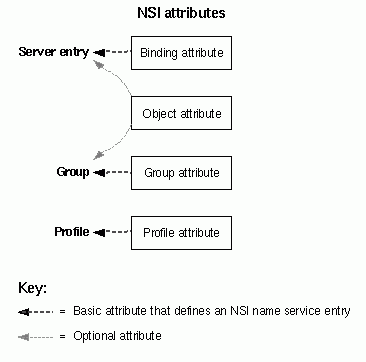
Usually, the distinct server entries, groups, and profiles concepts are adequate for using NSI. However, the way NSI stores RPC information allows you to combine server entries, groups, and profiles into a single directory service entry. To store information about RPC applications in a directory service entry, the RPC directory service interface defines several RPC-specific directory service attributes, or NSI attributes. NSI attributes contain information about RPC applications in a directory service entry. The NSI attributes are as follows:
· NSI binding attribute
The binding attribute stores binding information and interface identifiers (interface UUID and version numbers) exported to the server entry. This attribute identifies a directory service entry as a server entry.
· NSI object attribute
The object attribute stores a list of one or more object UUIDs. Whenever a server exports any object UUIDs to a server entry, the server entry contains an object attribute as well as a binding attribute. When a client imports from that entry, the import operation returns an object UUID from the list stored in the object attribute.
· NSI group attribute
The group attribute stores the entry names of the members of a single group. This attribute identifies a directory service entry as an RPC group.
· NSI profile attribute
The profile attribute stores a set of profile elements. This attribute identifies a directory service entry as an RPC profile. The following figure represents the correspondence between NSI attributes and the different directory service entries: server entries, groups, and profiles.
NSI Attributes

Any directory service entry can contain any combination of the four NSI attributes. However, to facilitate administrating directory service entries, avoid creating binding, group, and profile attributes in the same entry. Instead, use distinct directory service entries for server entries, groups, and profiles. The object attribute, in contrast, is designed as an adjunct to another NSI attribute, especially the binding attribute.
When implementing the resource model or when used to distinguish server instances, a server entry contains an object attribute as well as a binding attribute. On finding a server entry whose binding attribute contains compatible binding information, an NSI search operation also looks in the entry for an object attribute. For groups whose membership is selected according to a shared object or set of objects, it may be useful to export those objects to the group. In this case, the directory service entry of the group contains both group and object attributes. For reading the object UUIDs in the NSI object attribute in any directory service entry, NSI provides a set of object inquiry operations, called using the rpc_ns_entry_object_inq_{begin,next,done}( ) routines.
Using separate entries facilitates administration of the namespace; for example, by enabling entry names to specifically describe their contents. Keeping server entries, profiles, and groups separate allows clear references to each of them.
Note: In addition to any NSI attributes, a directory service entry contains other kinds of directory service attributes. Every entry in a namespace contains standard attributes created by the directory service. NSI operations rely on some standard attributes to identify and use an entry.